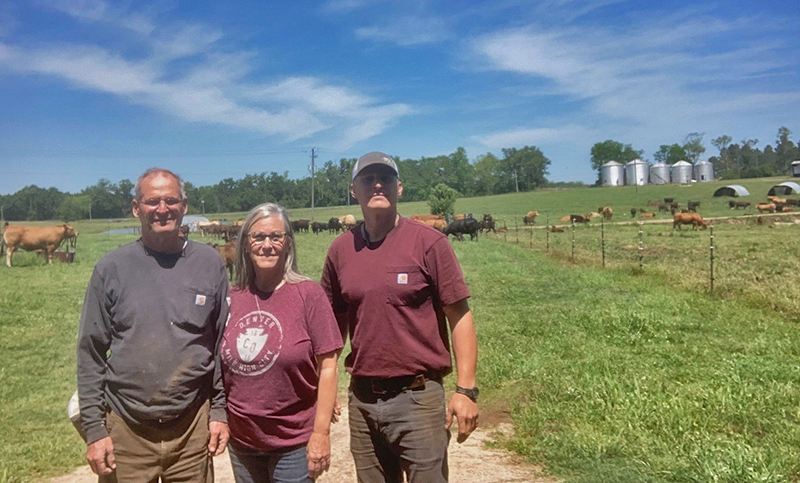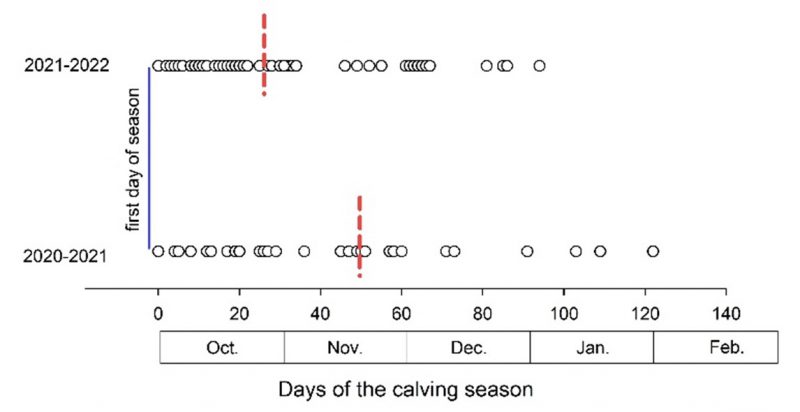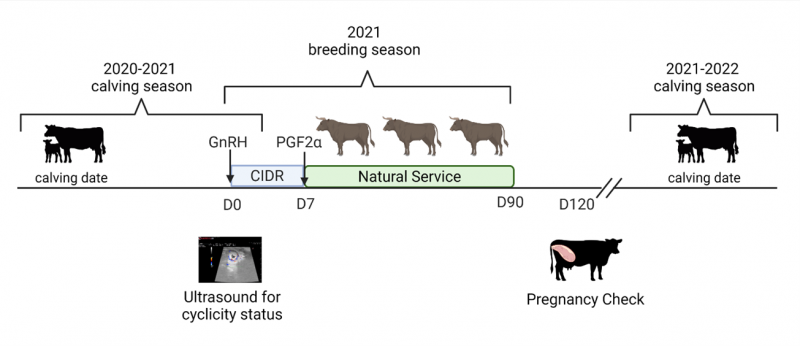Angela Gonella, UF/IFAS Cattle Reproduction Specialist, Doug Mayo, UF/IFAS Extension Jackson County, Daniella Heredia, PhD student, Camila Santos, NFREC Reproduction Lab Intern, and Oscar Alejandro Ojeda, NFREC Reproduction Lab Volunteer

Gordon (left), Lady (center) and Christopher (right) Dietrich raise crops and cattle on their farm near Graceville, Florida. Credit: Dietrich Family
The Dietrich family’s farm near Graceville (Jackson County) is an excellent example of business diversification. Their primary focus is a row crop operation producing corn, peanuts, and cotton. They also have a 90-cow commercial cow-calf operation to make use of pastures in areas less suitable for crops, and for grazing winter cover crops after crop harvest. In the summer, they even offer swimming lessons for rural kids to learn to swim.
The Dietrichs are also an excellent example of a family that has benefited from a strong relationship with UF/IFAS Extension. They often consult with Jackson County Extension Agents for ideas to improve their farm. At the 2020 Northwest Florida Beef Conference, the Dietrichs heard a presentation on Managing Reproduction Efficiency; they were very interested in one of the key points in this presentation: reducing the calving season using estrus synchronization. Their interest resulted in another consultation with one of their County Extension Agents, Doug Mayo. That consultation lead to a team from the NFREC-Reproduction Lab visiting their operation and helping them to implement the plan detailed below.
–
The Dietrichs had records of the calving dates for their herd from the 2020-2021 calving season. This represented an excellent opportunity for comparison to see if we could modify the calving distribution by using Timed-Natural breeding protocols with herd synchronization. If you are not familiar with these protocols, they used estrous synchronization and then turn the bulls out with the cows. No artificial insemination was conducted during the first breeding season. These protocols aim to make a group of cows come into heat during the first week of the breeding season and help females in anestrus start cycling again.
Why do you want most of your cows to come on heat at the beginning of the breeding season? This answer is simple – the sooner, the better. The sooner the cow gets pregnant, the sooner that calf will be born. The cow will have more time to recover after birth and, therefore, provide more chances of becoming pregnant in the subsequent breeding season. Also, calves conceived early will be born earlier in the calving season. The Dietrichs market their calves through a local board sale as a group, so earlier born calves meant extra pounds at weaning. Remember that the average daily gain from birth to weaning is about 1.5-2 pounds per day. Therefore, every extra day that a calf has with his mother means additional dollars in your pocket. Additional information about this could be find at: Gonella 2019, Gonella 2020, and Gonella et al. 2021.
The synchronization protocol implemented at Dietrich’s Farm during the 2021 breeding season was the basic 7-day Co synch + CIDR protocol (Figure 1). On day 0, we inserted a CIDR vaginal insert and applied one dose of GnRH. Then seven days later, we removed the CIDR, applied one dose of prostaglandin, and immediately released the bulls with the cows. We used four bulls to cover 83 cows and 19 heifers. But, because we love to collect data, we also perform an ultrasound the day the CIDR was inserted. During that ultrasound, we evaluated the ovaries to determine the percentage of cows that were already cycling. We repeated this ultrasound the following year, during the 2022 breeding season.
–
The bulls remained with the cows for three months, and a private veterinarian conducted a pregnancy diagnosis. Next, during the 2021-2020 calving season, the Dietrich family recorded calving dates of their calves. And then, we compared the data from the two subsequent calving seasons (2020-2021 season vs. 2021-2022 season) to analyze if we had indeed modified the calving distribution by using this timed-natural breeding protocol.
In figure 2 below, we graphed the calving dates from the two seasons for comparison. In this graph, every point (white circles) represents a calf born during the 2020-2021 calving season or during the 2021-2022 calving season. Then we compared the date of the end of the calving season, the total length of the calving season (interval from the first to the last calves that were born during each season) and used the red broken lines to designate when 50% of the calves were born during each season.

Figure 2: Analysis of the calving dates and calving distribution during the 2020-2021 and 2021-2022 calving seasons.
–
In the 2020-2021 calving season, the last calf was born in late January, in the 2021-2022 calving season, the last calf was born in early January (29 days earlier). The total length of the 2020-2021 calving season was 122 days compared to 94 days for the 2021-2022 calving season with herd synchronization. Finally, during the 2020-2021 season, 50% of the calves were born after 65 days. While in the 2021-2022 season, this point was reached 28 days after the beginning of the season. Therefore, we accomplished our goal after just one year of implementing a Timed-Natural breeding protocol. We were also successful in modifying the calving distribution at Dietrich’s farm.
Moreover, it is essential to mention that we also found a considerable difference in the percentage of cows cycling at CIDR insertion. While in the 2021 breeding season, 69% of the cows were cycling at CIDR insertion, in the 2022 breeding season, 90% of the cows were cycling. This is easily explained when you consider that cows calved earlier that year and therefore had more time to recover after birth. For the 2022 breeding season, the Dietrichs decided to also utilize artificial insemination (AI) after synchronizing. We were able to get 60% pregnant to superior genetic AI bulls on the first day of the season, so the hope is that this practice will also enhance their weaning weights for this year’s group of calves. We are looking forward to evaluating the calving distribution in the upcoming calving season.
There are a variety of tools that can be used to improve the reproductive efficiency of your herd. If you have any questions, or if you are interested in making changes to your reproductive program, do not hesitate to contact your local extension agent. We are here to help you.
- Heat Stress and its Impact on Cattle Reproduction - March 14, 2025
- Fall is Here.Time for Pregnancy Testing Cattle! - September 13, 2024
- How Stress Impacts Cattle Reproduction - March 15, 2024


